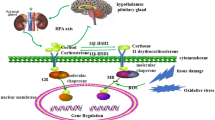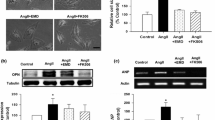Abstract
Metabolic syndrome-induced cardiac hypertrophy is a global concern leading to an increase in the morbidity and mortality of patients, with the signalling mechanism associated with them still unclear. The present study attempts to understand the metabolic syndrome-associated cardiac hypertrophy through an in vitro model using external stimuli well known for inducing metabolic disorders, i.e. dexamethasone (DEX), a synthetic glucocorticoid. DEX (0.1 and 1 μM) promoted cardiac hypertrophy in H9C2 cells at 4 days of treatment as evidenced through increased cell size and protein content. A significant induction in foetal gene reprogramming was observed, confirming the establishment of hypertrophy. Moreover, the hypertrophic response at 4 days was perceived to be physiological at 0.1 μM and pathological at 1 μM based on α-MHC and IGF1R expression, but complete inhibition in the PKB/AKT expression confirmed it to be pathological hypertrophy at both the concentrations (0.1 and 1 μM). The present study reports for the first time the mechanistic insights into DEX-mediated hypertrophy. It is hypothesized to be orchestrated through the activation of AT1R that is involved in the alteration of the cardiac isoform of SERCA2 expression perturbing the calcium homeostasis. This leads to the activation of calcineurin B, independent of NFAT involvement, which in coordination with ROS induces the activation of JNK of the MAPK signalling.







Similar content being viewed by others
References
Mottillo S, Filion KB, Genest J, Joseph L, Pilote L, Poirier P, Rinfret S, Schiffrin EL, Eisenberg MJ (2010) The metabolic syndrome and cardiovascular risk a systematic review and meta-analysis. J Am Coll Cardiol 56(14):1113–1132
Kehat I, Molkentin JD (2010) Molecular pathways underlying cardiac remodelling during pathophysiologic stimulation. Circulation 122(25):2727–2735
Frey N, Katus HA, Olson EN, Hill JA (2004) Hypertrophy of the heart-A new therapeutic target? Circulation 109:1580–1589
Takimoto E, Kass DA (2007) Role of oxidative stress in cardiac hypertrophy and remodelling. Hypertension 49:241–248
Gathercole LL, Morgan SA, Bujalska IJ, Stewart PM, Tomlinson JW (2011) Short- and long-term glucocorticoid treatment enhances insulin signalling in human subcutaneous adipose tissue. Nutr Diabetes 1(1):e3
Ren R, Oakley RH, Cruz-Topete D, Cidlowski JA (2012) Dual role for glucocorticoids in cardiomyocyte hypertrophy and apoptosis. Endocrinology 153(11):5346–5360
Oakley RH, Cidlowski JA (2015) Glucocorticoid signalling in the heart: a cardiomyocyte perspective. J Steroid Biochem Mol Biol S0960–0760(15):00094-1
De Vries WB, Van der Leij FR, Bakker JM, Kamphuis PJ, Van Oosterhout MF, Schipper ME, Smid GB, Bartelds B, Van Bel F (2002) Alterations in adult rat heart after neonatal dexamethasone therapy. Pediatr Res 52:900–906
Muangmingsuk S, Ingram P, Gupta MP, Arcilla RA, Gupta M (2000) Dexamethasone induced cardiac hypertrophy in newborn rats is accompanied by changes in myosin heavy chain phenotype and gene transcription. Mol Cell Biochem 209:165–173
Whitehurst RM Jr, Zhang M, Bhattacharjee A, Li M (1999) Dexamethasone-induced hypertrophy in rat neonatal cardiac myocytes involves an elevated L-type Ca2+ current. J Mol Cell Cardiol 31:1551–1558
Lister K, Autelitano DJ, Jenkins A, Hannan RD, Sheppard KE (2006) Cross talk between corticosteroids and alpha-adrenergic signalling augments cardiomyocyte hypertrophy: a possible role for SGK1. Cardiovasc Res 70:555–565
Tzur A, Moore JK, Jorgensen P, Shapiro HM, Kirschner MW (2011) Optimizing optical flow cytometry for cell volume-based sorting and analysis. PLoS One 6(1):e16053
Bradford MM (1976) A rapid and sensitive method for the quantitation of microgram quantities of protein utilizing the principle of protein-dye binding. Anal Biochem 72:248–254
Ramadevi Mani S, Lakshmi BS (2010) G1 arrest and caspase-mediated apoptosis in HL-60 cells by dichloromethane extract of Centrosema pubescens. Am J Chin Med 38(6):1143–1159
Sangeetha KN, Sujatha S, Muthusamy VS, Anand S, Nithya N, Velmurugan D, Arun B, Lakshmi BS (1800) (2010) 3β-taraxerol of Mangifera indica, a PI3K dependent dual activator of glucose transport and glycogen synthesis in 3T3-L1 adipocytes. BBA—Gener Subj 3:359–366
Xie M, Burchfield JS, Hill JA (2013) Pathological ventricular remodelling: mechanisms: part 1 of 2. Circulation 128(4):388–400
Paolisso G, De Riu S, Marrazzo G, Verza M, Varricchio M, D’Onofrio F (1991) Insulin resistance and hyperinsulinemia in patients with chronic congestive heart failure. Metabolism 40:972–977
Witteles RM, Fowler MB (2008) Insulin-resistant cardiomyopathy clinical evidence, mechanisms, and treatment options. J Am Coll Cardiol 51:93–102
Ingelsson E, Sundström J, Arnlöv J, Zethelius B, Lind L (2005) Insulin resistance and risk of congestive heart failure. JAMA 294:334–341
Patel JV, Cummings DE, Girod JP, Mascarenhas AV, Hughes EA, Manjula Gupta M, Lip GYH, Reddy S, Brotman DJ (2006) Role of metabolically active hormones in the insulin resistance associated with short-term glucocorticoid treatment. J Negat Results BioMed 5:14
Watkins SJ, Borthwick GM, Arthur HM (2011) The H9C2 cell line and primary neonatal cardiomyocyte cells show similar hypertrophic responses in vitro. Vitro Cell Dev Biol Anim 47(2):125–131
Kolwicz SC Jr, Tian R (2011) Glucose metabolism and cardiac hypertrophy. Cardiovasc Res 90(2):194–201
Nascimben L, Ingwall JS, Lorell BH, Pinz I, Schultz V, Tornheim K et al (2004) Mechanisms for increased glycolysis in the hypertrophied rat heart. Hypertension 44:662–667
Kagaya Y, Kanno Y, Takeyama D, Ishide N, Maruyama Y, Takahashi T et al (1990) Effects of long-term pressure overload on regional myocardial glucose and free fatty acid uptake in rats. A quantitative autoradiographic study. Circulation 81:1353–1361
Sangeetha KN, Shilpa K, Jyothi Kumari P, Lakshmi BS (2013) Reversal of dexamethasone induced insulin resistance in 3T3L1 adipocytes by 3β-taraxerol of Mangifera indica. Phytomedicine 20:213–220
Reddy DS (1997) Cellular and molecular biology of cardiac hypertrophy. Curr Sci 72(1):13–30
Komuro I, Yazaki Y (1993) Control of cardiac gene expression by mechanical stress. Annu Rev Physiol 55:55–75
Knowlton KU, Rockman HA, Itani M, Vovan A, Seidman CE, Chien KR (1995) Divergent pathways mediate the induction of ANF transgenes in neonatal and hypertrophic ventricular myocardium. J Clin Invest 96(3):1311–1318
McMullen JR, Jennings GL (2007) Differences between pathological and physiological cardiac hypertrophy: novel therapeutic strategies to treat heart failure. Clin Exp Pharmacol Physiol 34:255–262
Sizemore JMK, Dixon EN, Baute AJ, Waikel RL (2012) Regulation of Alpha-Myosin Heavy Chain in cardiac remodelling associated with pregnancy. FASEB J 26(922):2
McMullen JR, Shioi T, Huang WY, Zhang L, Tarnavski O, Bisping E, Schinke M, Kong S, Sherwood MC, Brown J, Riggi L, Kang PM, Izumo S (2004) The IGF1 receptor induces physiological heart growth via the phosphoinositide 3-kinase (p110alpha) pathway. J Biol Chem 279(6):4782–4793
Sugden PH, Fuller SJ, Weiss SC, Clerk A (2008) Glycogen synthase kinase 3 (GSK3) in the heart: a point of integration in hypertrophic signalling and a therapeutic target? A critical analysis. Br J Pharmacol 153(1):S137–S153
Aoki H, Sadoshima J, Izumo S (2000) Myosin light chain kinase mediates sarcomere organization during cardiac hypertrophy in vitro. Nat Med 6(2):183–188
Katoh D, Hongo K, Ito K, Yoshino T, Kayama Y, Kawai M, Date T, Yoshura M (2014) Corticosteroids increase intracellular free sodium ion concentration via glucocorticoid receptor pathway in cultured neonatal rat cardiomyocytes. IJCHV 3:49–56
De P, Roy SG, Kar D, Bandyopadhyay A (2011) Excess of glucocorticoid induces myocardial remodeling and alteration of calcium signaling in cardiomyocytes. J Endocrinol. 209(1):105–114
Frey N, Olson EN (2003) Cardiac hypertrophy: the good, the bad, and the ugly. Annu Rev Physiol 65:45–79
De Windt LJ, Lim HW, Taigen T, Wencker D, Condorelli G, Dorn GW, Kitsis RN, Molkentin JD (2000) Calcineurin-mediated hypertrophy protects cardiomyocytes from apoptosis in vitro and in vivo an apoptosis-independent model of dilated heart failure. Circ Res 86:255–263
Huang H, Joseph LC, Gurin MI, Thorp EB, Morrow JP (2014) Extracellular signal-regulated kinase activation during cardiac hypertrophy reduces sarcoplasmic/endoplasmic reticulum calcium ATPase 2 (SERCA2) transcription. J Mol Cell Cardiol 75:58–63
Kawase Y, Hajjar RJ (2008) The cardiac sarcoplasmic/endoplasmic reticulum calcium ATPase: a potent target for cardiovascular diseases. Nat Clin Pract Cardiovasc Med 5(9):554–565
Pinz I, Tian R, Belke D, Swanson E, Dillmann W, Ingwall JS (2011) Compromised myocardial energetics in hypertrophied mouse hearts diminish the beneficial effect of overexpressing SERCA2a. J Biol Chem 286(12):10163–10168
Tilley DG (2011) G protein-dependent and –independent signaling pathways and their impact on cardiac function. Circ Res 109(2):217–230
Molkentin JD (2004) Calcineurin-NFAT signaling regulates the cardiac hypertrophic response in coordination with the MAPKs. Cardiovasc Res 63(3):467–475
Zelarayan L, Renger A, Noack C, Zafiriou M-P, Gehrke C, Van der Nagel R, Dietz R, de Windt L, Bergmann MW (2009) NF-kappaB activation is required for adaptive cardiac hypertrophy. Cardiovasc Res 84:416–424
Suh KS, Tatunchak TT, Crutchley JM, Edwards LE, Marin KG, Yuspa SH (2003) Genomic structure and promoter analysis of PKC-delta. Genomics 82:57–67
Feng JQ, Xing L, Zhang JH, Zhao M, Horn D, Chan J, Boyce BF, Harris SE, Mundy GR, Chen D (2003) NF-kappaB specifically activates BMP-2 gene expression in growth plate chondrocytes in vivo and in a chondrocyte cell line in vitro. J Biol Chem 278:29130–29135
Armstrong K, Robson CN, Leung HY (2006) NF-kappaB activation upregulates fibroblast growth factor 8 expression in prostate cancer cells. Prostate 66:1223–1234
Vega RB, Harrison BC, Meadows E, Roberts CR, Papst PJ, Olson EN, McKinsey TA (2004) Protein kinases C and D mediate agonist-dependent cardiac hypertrophy through nuclear export of histone deacetylase 5. Mol Cell Biol 24:8374–8385
Acknowledgments
This work was supported by UGC-Dr D S Kothari Postdoctoral fellowship awarded to Dr Sangeetha KN, by the University Grants Commission, Government of India [Award letter No. F. 13-673/2012(BSR)].
Author information
Authors and Affiliations
Corresponding author
Ethics declarations
Conflict of interest
The authors declare that there are no conflicts of interest.
Rights and permissions
About this article
Cite this article
Sangeetha, K.N., Lakshmi, B.S. & Niranjali Devaraj, S. Dexamethasone promotes hypertrophy of H9C2 cardiomyocytes through calcineurin B pathway, independent of NFAT activation. Mol Cell Biochem 411, 241–252 (2016). https://doi.org/10.1007/s11010-015-2586-9
Received:
Accepted:
Published:
Issue Date:
DOI: https://doi.org/10.1007/s11010-015-2586-9




